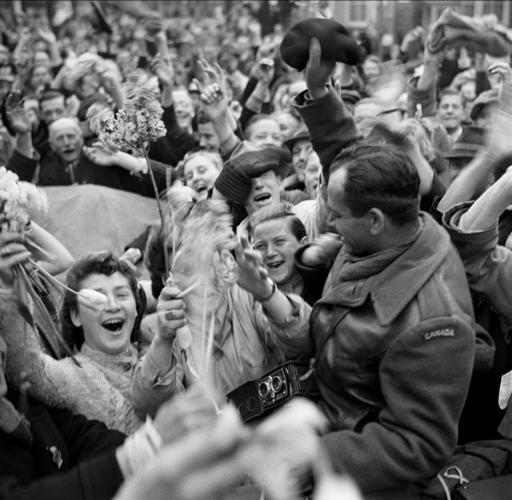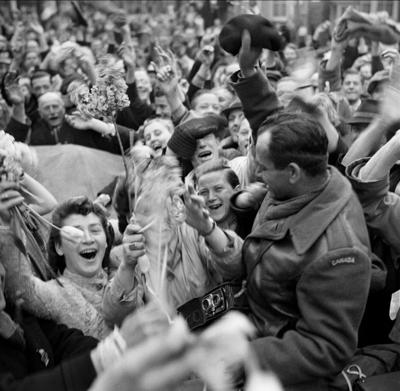Hendrika Meninger, 93, is sharing her memories of World War II with a class of students from Parry Sound High School.
When the Germans invaded the Netherlands, Meininger was eight. The youngest of eight children, she lived with her parents in Rotterdam. As the war ground on, Meninger’s family subsisted on dinners of endives her dad managed to scrounge up; her parents kept the kids in bed much of the time so they wouldn’t burn calories. One day, when Meninger was on a rare outing with her sister, sirens began sounding; the sisters entered a shelter just as bombs started falling. Meininger sat on the lap of a woman who tried to console her with peppermint candy. When she and her sister got home, Meninger recalls, their parents were shocked and overjoyed to see them.
“That day, I grew up,” said Meninger. “I knew that life could change.”
The students listening intently are among more than 1,000 high schoolers, teachers and staff from 34 high schools across Canada who are now in the Netherlands to celebrate the 80th anniversary of VE Day, which marks the 1945 liberation of the country by Allied forces, including Canada. WorldStrides Canada, an educational travel company headquartered in Etobicoke, organized the tour.

Hendrika Meininger, 93, shared her experiences living through the occupation of the Netherlands by the Germans, with Ontario high school students.
SuppliedRick Lund, the history teacher who brought Meninger to speak to his class, is leading a group of 40 students overseas. Each of them has researched a fallen Canadian soldier. Once in the Netherlands, they visit the cemetery where these soldiers are buried.
“The students really gain an understanding of what was sacrificed,” said Lund.
Leila Kennedy, 17, is visiting the Groesbeek Canadian War Cemetery to see the grave of Private Woodrow Beverley Brown. In Lund’s history class, Kennedy learned about the Canadian soldier who was 19 when he died just over the border in Germany on March 9, 1945. It’s a long way from the farm in Lindsay, Ont., where Brown worked since Grade 7, after dropping out of school. He enlisted on Oct. 21, 1944, at 18. He was five feet five inches tall and 142 pounds. His hobbies included swimming and hockey. He wanted to learn mechanics after his tour. He wrote three letters to the pastor of his church while in the service. His last foster mother was the beneficiary of his will.
Kennedy said that before she signed up for the school trip, she wasn’t very interested in history. That started to change after she chatted with her great grandmother, Josephine, who worked on a wartime factory line, making mirrors for Jeeps. The women working the line would scribble their addresses on the back of the mirror and scrawl, “If you want someone to write to ….” Some of the women added a lipstick kiss. Josephine received one letter from a soldier who said he decided to follow behind the Jeep his friends were in at the last minute; the Jeep was hit and all of the soldiers were killed.

Leila Kennedy, 17, a student from Parry Sound High School, visits the grave of a Canadian soldier at the Groesbeek Canadian War Cemetery in the Netherlands.Â
Rick Lund suppliedTim Cook, chief historian and director of research at the Canadian War Museum, and author and editor of 19 books, including “The Fight for History: 75 Years of Forgetting, Remembering and Remaking Canada’s Second World War,” said this history “is an important part of our story.”
“1.1 million Canadians served out of a population of 11.5 million,” said Cook. “One in 10 Canadians served in the war. There were 45,000 Canadians killed in the war. There are fewer than 5,000 veterans left. Their voices will be silenced in a couple of years. The 80th anniversary is an important one — how many veterans will be with us on the 90th?”
To mark this anniversary of the end of the conflict, the Canadian War Museum, supported by the Royal Canadian Legion, has created an exhibition called “Last Voices of the Second World War,” which presents new interviews from some of the last surviving veterans of the war, as well as their family members.
Reg Harrison, 103, is one of those voices. A bomber pilot, Harrison survived four crashes. Harrison, like Meninger, visits schools to share his memories. “My reason for (talking) to the students is so they will never forget those who never came back,” he said.
For Harrison, that includes his friend Donaldson “Buddy” Holloway, who he met in flying school in Regina. After they shipped out to England, Buddy insisted Harrison add a note home at the bottom of Buddy’s letters to his fiancée, Jean Woods. “You never know, you might meet her,” Harrison recalled Buddy saying. In 1944, Harrison learned Buddy was killed in a training accident. In 1945, on his way home, he reluctantly stopped in to visit Jean. The planned two-day visit turned into four. He later proposed, saying he was a poor substitute for Buddy. Years later, the couple visited Buddy’s grave together. “Well, Buddy, Jean and I have come to say hello,” Harrison recalled saying. He left Jean at the grave and went in search of one of his crew who was buried there, too.

Reg Harrison (left) and Buddy Holloway around 1943.
Courtesy of Laurie HarrisonThis May, in the cemetery in the Netherlands, a light breeze blows and birds chirp as Lund’s group of students read out 90 names of Canadian veterans buried there. Kennedy stands at the grave of Private Brown, whose officer’s assessment revealed a “happy-go-lucky” man who thought the war would “improve” him. He died less than a month before the Allies declared victory.
“It takes you aback, when you see the rows on rows of graves and it’s so calm and peaceful,” said Kennedy. “He gave his life so I could enjoy a peaceful one.”































To join the conversation set a first and last name in your user profile.
Sign in or register for free to join the Conversation